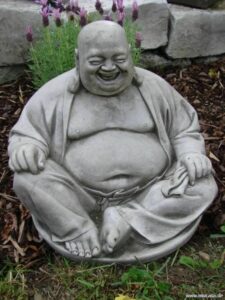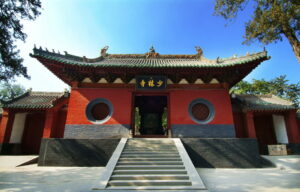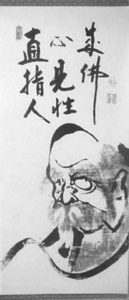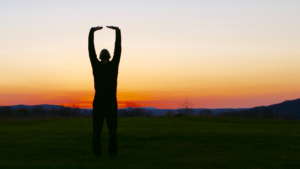
In Ancient Beginnings of the Martial Arts, we talked about how Da Mo crossed a great expanse of sea and land to finally end up at the Shao Lin Temple in Henen Province. Did you ever wonder how the Temple came to be? Here is a wonderful story about the founding of the Shao l]Lin Temple.
Batuo, an Indian monk, preceded Da Mo’s entrance into the Shao Lin Temple by one-hundred and fifty years.
The first temple was built in 377 AD in the Songshan Mountain range, in the Chinese province of Henan. There is something magical about these mountains, and here is one story of how this famous monastery came to be.
Songshan consists of two major ranges, the Taishi Mountain in the east and the Shaoshi Mountain in the West. Songshan has been described as a “pretty damsel having an afternoon nap in the spring.”
There is brilliant history and legend surrounding this area, which was the heart of the beginning of the Chinese culture thousands of years ago. Master Yong tells the legend in The Complete Book of Shaolin of three travelers who climbed Shaoshi Mountain on an auspicious day in 495. The traveler from the south was a Taoist priest, from the north was a Buddhist monk, and a rich landlord climbed up the western face of the mountain.
A Heavenly Vision
They reached the top, clouds gathered and mingled with a heavy mist. All three sat on a large round rock, but none knew of the other’s existence. Suddenly, the clouds parted, and a vision of heaven appeared. Written across this celestial majestic monastery were the characters ZHU LIN SI, which means “Monastery of the Bamboo Forest.”
The men saw the vision of a young monk talking to his master. The boy asked his master that since Zhulin Monastery had risen to heaven, would there be a monastery on earth? The master pointed toward the southeast. “At the northern side of Shaoshi foothill – with the nine lotus pinnacles in front and the five bosom peaks behind, and with a majestic waterfall on the west supplying a crystal-clear stream flowing towards the east.”
The three mortals looked in the direction pointed out by the older monk, and they saw the vision of a magnificent monastery built with red bricks and jade-colored tiles, and in gold, the characters across the entrance spelled “SHAO LIN SI.”

The three men uttered a sigh of disbelief, the vision was shattered. Suddenly aware of one another. They hurried down the mountain in their separate ways, plotting to themselves how they could secure this glorious piece of property.
The landlord thought he would build a most magnificent house and soon be the richest man on earth.
The priest thought if he moved his family grave there his descendants would gain power and prestige.
The monk thought, “What a lovely, sacred spot. If I build a temple there, I can help many people achieve enlightenment.”
Securing the Claim

Late that night, the monk went to the mountain and buried his shoe to mark his claim. Early the next morning, the priest went to the same spot and thought he was lucky no one had claimed the land yet, so he put a stick in the ground. The landlord came by later that day. He looked for a place to hang his hat and saw the stake, on which he hung his hat, marking his claim!
Several days later, each man, at the same time, brought their workmen to begin building their dream. They began to argue over who had the claim. Emperor Xiao Wen and his imperial entourage was passing by, and he stopped and asked the men what the argument was about.
They told him. Wise King Wen determined that the hat was on top of the pole and the pole was on top of the shoe, so the person that placed the shoe was the rightful owner.
The monk was thrilled. His name was Batuo, an Indian monk who had come from India to spread Buddhism. Emperor Wei built the Shao Lin Temple for Batuo so that he could teach people the way to enlightenment. There was no practice of the martial arts, just long hours of meditation.
Today Batuo is immortalized as the “Happy Buddha.”

Da Mo shows up 150 years later…
When Da Mo arrived at the Shao Lin temple in 527, he found the monks spiritually enlightened, happy with their life, and accustomed to the rigid discipline of the monastery.
But he also found them physically weak and unhealthy. Their physical states did not bother the monks, though, because they regarded their bodies as Chou Pi Nang, or “notorious skin bag”. They felt if they spent their time in attaining Buddhahood, why spend time on the physical body?
Da Mo believed the body and spirit were connected, and to maintain one, you had to maintain the other. The man was fit. He trained in martial arts from a young boy, he was a soldier, he was a Buddhist monk. Think of the many miles he traveled from his home in India to Henan Province. Did he travel by foot, chariot, camel, horse? Imagine the journey from India to China in the 6th century, and you will have an idea of the stamina it took.
Da Mo whipped the monks into shape. He taught them his fighting art and his spiritual art. He got them moving and active. In a short time, the monks became healthy, and as their training increased, they became the root of the greatest fighting force in the world – the martial arts.
Qigong – “Moving Meditation”
Qigong dates back long before Da Mo went to China, but the eight moves of The Eight Pieces of Brocade, a popular and very effect set of Qigong movements, are the first eight moves of the 18 Hands of Lohan, which are attributed to Da Mo.
If you have not tried Qigong, check it out. If this simple art turned out-of-shape Buddhist monks into healthy, robust monks 1800 years ago, think what it can do for you. Qigong taps into your qi, your life force. It can heal your body and calm your mind. They call it “moving meditation,” and is great for those of us who find sitting on a cushion for any length of time to meditate a real challenge.
By concentrating on your movements and your breathing, you are keeping your mind clear of your thoughts and worries. As you push those thoughts away with your breath, you will find an amazing release of tension throughout your body.
The idea of meditation is to give your mind a break from thinking. As in any martial art, you are so busy concentrating on your movements you forget about your troubles and your woes. Practiced properly, all styles of martial arts have components of Qigong.
Qigong teaches you to properly use your breath – and your qi – to obtain ultimate power. Adding a few minutes of daily Qigong practice will maximize strength and flexibility. The slow, mindful movements, coupled with imagery and breathing, are better than a cup of coffee to start your day.
Be a Happy Buddha, but at the same time, take care of your “notorious skin bag.” It will serve you well.

Three excellent resources of Qigong:
Dr. Yang, Jing-Ming Eight Simple Qigong Exercises for Health. The Eight Pieces of Brocade.
If you prefer a video, Lee Holden has a great collection of videos that are easy to follow.
